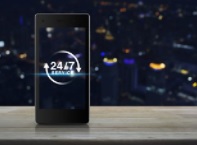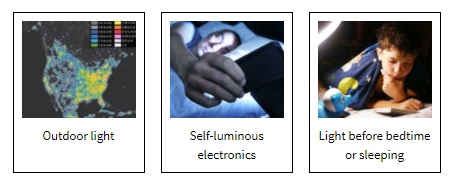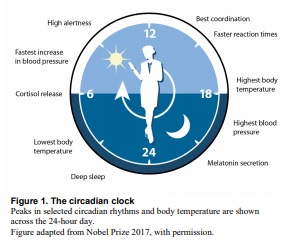
BACKGROUND INFORMATION
Modern electric lighting enables people to work, sleep, eat, and receive services throughout the 24-hour day. As a result, many individuals encounter new patterns and types of electrical light, change the timing of their meals, and experience sleep disturbances and other stresses. Those factors can disrupt circadian rhythms and possibly lead to adverse health effects such as cancer.

NTP studied two exposure scenarios related to modern lighting practices.
1. Night shift work
Night shift work is defined as working three hours between 12 and 5am. It is a complex exposure scenario and includes the following.

2. Sources of electrical light at night

Why is it important to study night shift work and light at night?
According to the Centers for Disease Control and Prevention, more than 10 million adults in the U.S. frequently work night shifts. Frequent night shift work is more common among men, blacks, and non-Hispanics.
Night shift work may contribute to almost 12,000 new breast cancer cases per year in the U.S. The link between night shift work and breast cancer among black women is a research gap.
Exposure to indoor electric lighting is nearly ubiquitous in our society. Findings from the National Sleep Foundation show that 90% of Americans use some type of electronic device a few nights per week within one hour of bedtime. In 2016, satellite imaging data of the Earth at night (see Figure 5) indicated that more than 99% of the U.S. population lived under light-polluted skies at night.
NTP Evaluation
NTP used systematic review methods and established criteria to reach its cancer hazard conclusions. These conclusions are based on scientific judgment with consideration given to all relevant information.
What did the evaluation find?
High confidence that persistent night shift work that disrupts circadian rhythms can cause breast cancer in women and may cause prostate cancer in men. Persistent night shift work is defined as frequent and long-term night shift work, especially beginning in early adulthood.
- The exact conditions of persistent night shift work are hard to define as duration and frequency may depend on their specific combination.
Moderate confidence for a causal relationship between human cancer and certain lighting conditions that cause circadian disruption. Certain lighting conditions are defined as excessive LAN exposure combined with insufficient daylight exposure.
- The lighting conditions at night that lead to circadian disruption depend on a combination of light characteristics such as wavelength, exposure duration, light intensity or levels, and timing.
Q: How does circadian disruption work?

Sunlight is the major external signal that synchronizes the master circadian clock to natural light-dark cycles we experience daily. To keep biological rhythms coordinated (see figure for example of daily rhythms), the master clock, which is located in the brain, sends signals to a large network of peripheral clocks that are in almost every cell of the body. Exposure to too much light at night, especially during times when people are typically asleep, is thought to contribute to circadian disruption and increased risk of cancer.
Q: How were the conclusions on persistent night shift work and certain lighting conditions reached?
NTP used systematic review methods to identify studies, evaluate study quality, and integrate evidence across studies.
For each exposure scenario (night shift work or LAN), NTP integrated the evidence from human and non-human studies of exposure and cancer, studies of circadian disruption, and studies of mechanisms (e.g., biological effects) to reach our conclusions.

Read more at: https://ntp.niehs.nih.gov/whatwestudy/assessments/cancer/completed/shiftwork/index.html
